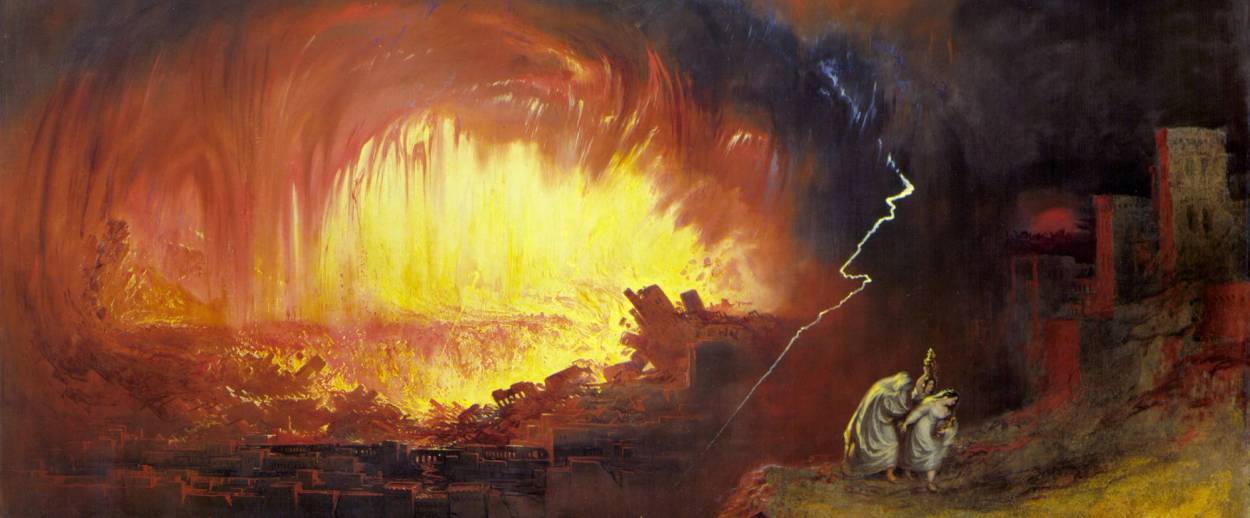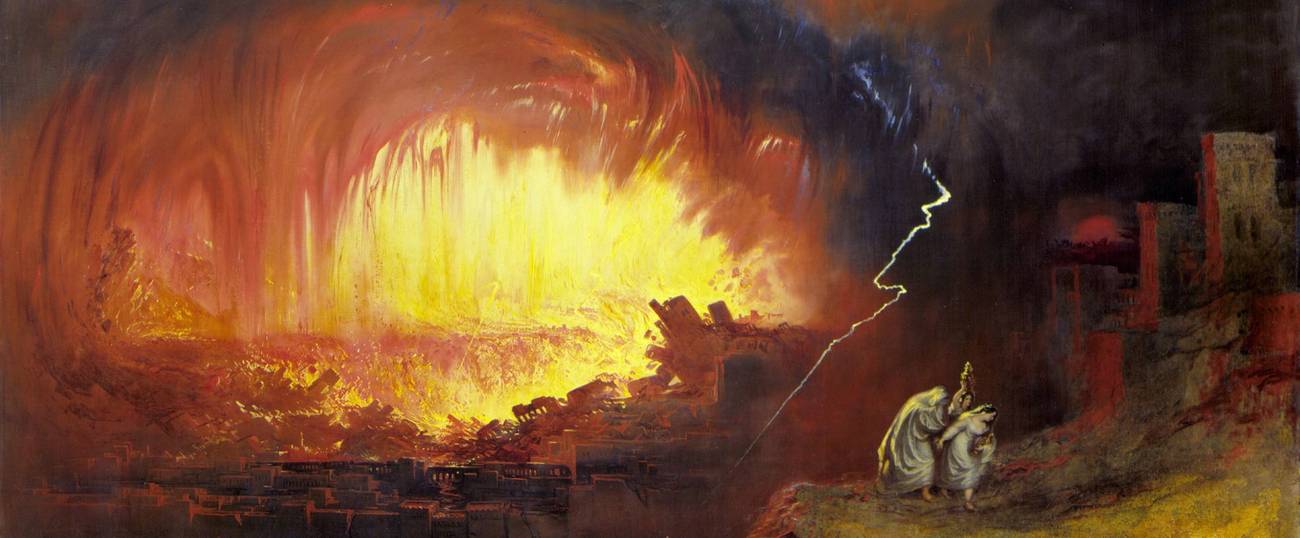Lessons From Sodom and Gomorrah
What happened in the ancient cities that drew the wrath of God?




In the story of Sodom and Gomorrah—recounted in the Torah in Parshat Vayera, which will be read this Shabbat—the Bible addresses the question of ethics head-on. These towns represent a human society so thoroughly corrupt that it is beyond the possibility of repair. There are other stories in which God finds human behavior to be abhorrent, but there is usually some redemption (as in the story of Nineveh in the book of Jonah), or a remnant remains that holds the potential to rebuild (like the living things in Noah’s ark). Only here does an entire place get annihilated with fire and brimstone.
What makes this place irredeemable? Some people assume that the biblical narrative is clear: It was “sodomy”—a particular male sex act—that infuriated God. But the oldest interpretations of the story see it very differently.
The prophet Ezekiel brings it up in one of his warnings to the kingdom of Judah in the sixth century BCE:
Only this was the sin of your sister Sodom: arrogance! She and her daughters had plenty of bread and untroubled tranquility; yet she did not support the poor and the needy. (Ezekiel 16:49)
Centuries later, the ancient rabbis fleshed out Ezekiel’s charge in a midrash—a snippet of biblical interpretation. Here is a passage from Genesis Rabbah, a collection of commentaries compiled in the third century CE:
There was an incident concerning two young girls who went down to fill pitchers with water from the spring.
One of them said to her friend, “Why is your face so sickly?”
The other said to her, “Our food is all gone and we are about to die.”
What did the first one do? She filled her pitcher with flour and switched the two, each girl taking what was in the hand of the other.
When [the people of Sodom] became aware of this, they took her and burned her.
The Holy Blessed One said, “Even if I wanted to keep silent, the judgment in the case of the young girl does not permit me to keep silent.”
This midrash paints a terrible picture: A young woman burned to death as punishment for an act of compassion. And her burning was not the work of hooligans. God uses legal terminology—“judgment” and “case” —implying that the people of Sodom took the compassionate girl to court for sneaking food to a starving neighbor. She was tried and convicted under the law of the land. In Sodom, feeding a hungry person was a criminal act that carried the death penalty. The act that forced God’s interference was a legal one.
Like most midrash, this interpretation roots itself in an oddly worded phrase in the Bible. In Genesis 18 we hear God describing the decision-making process:
The Lord said, “Because great is the outcry of Sodom and Gomorrah and because weighty indeed is their sin, I shall go down and see whether they have done entirely in accordance with its outcry that has come to me. If not, I shall know. (Genesis 18:20-21)
The ancient rabbis found it odd that the text speaks of “the outcry of Sodom and Gomorrah”—two cities—and then of “its outcry” in the singular. Shouldn’t it say “their outcry?” For the rabbis, this mismatched “it” is an opportunity, a hint about a direction to investigate. There was something that cried a cry that wafted up to God, something singular, not plural, and in response to that cry God began the process that led to annihilation. An explanation of what “it” refers to will be an explanation of whose pain awakened God’s action.
Every noun in Hebrew is either masculine or feminine. The form of “it” used in “its outcry” could refer to any feminine noun, or it could refer to a female person. If it were a person, we would translate it “her outcry,” but in Hebrew there is no way to distinguish “it” and “her.” The search is narrowed: The outcry comes from something feminine and singular, a person or a thing.
A sensible reader whose goal is to understand the plain meaning of the text might dismiss this entire search as nitpicking. It happens that the Hebrew word for “city” is feminine, so perhaps “it” is the place itself. Perhaps a minor editing problem led to using “its outcry” instead of “their outcry” in speaking of two cities.
The ancient rabbis were not sensible readers in this way. The idea of dismissing a peculiarity as an editing problem would horrify them. It would amount to throwing out a precious clue that might reveal something of great significance. When they perceived a slight lump in the fabric of the text, they were compelled to investigate further. They imagined peeling back the fabric to reveal another world of meaning, an alternate reality that lies beneath the text, where deeper levels of meaning might be discovered.
The midrash ends like this:
The Holy Blessed One said, “Even if I wanted to keep silent, the judgment in the case of the young girl does not permit me to keep silent.”
Thus, it does not say “If in accordance with their outcry,” but rather “If in accordance with her outcry”—the young girl’s.
The midrash solves the grammar problem: Whose outcry did God hear? The outcry of one vulnerable young girl, abused by her own city. At the same time, the midrash delivers a strong message: God stands up for the generous and the vulnerable against the stingy and the powerful. It was the cry of a young girl that caught God’s attention and compelled God to act, a cry not loud, but thin and true. The image of this righteous girl crying out to God caught the imagination of the Jewish tradition and for many she has become a symbol of the sin of Sodom.
But there is another version of this midrash that takes the issue a step further. The alternate version ends like this:
The Holy Blessed One said, “Even if I wanted to keep silent, the judgment in the case of the young girl does not permit me to keep silent.”
Thus, it does not say “If in accordance with their outcry,” but rather “If in accordance with its outcry.” What is “it”? “It” is the judgment in the case of the young girl.
According to this version, it is not the cry of the girl herself that turns God’s head. Now it is the judgment in her case that cries out.
An innocent girl, an extraordinarily brave and generous girl, was abused in Sodom. But according to this version of the midrash, there was another level of abuse that was impossible for God to ignore, and that was the abuse of judgment itself. By the law of Sodom, the case of The People v. Girl was judged fairly. She was sentenced to death by burning, and the sentence was carried out. It was not even that the judges were corrupt. The problem was that law itself was perverted. Judgment cries out in rage: If legal action results in cruel injustice then what is the value of judgment?
For most people, the abuse of an abstract concept is not as emotionally compelling as the abuse of a little girl. But the idea that her treatment reflected the ethical stance of her society is truly horrifying. It suggests that in a society whose communal values are corrupt, it eventually becomes impossible for individuals to live ethical lives. Ethics and morality are not only attributes of individual people. Ethics exist or do not exist in a community. Whether individual people are good or bad, it is the collective values of the community that make ethical life possible.
Later in the biblical story, when God’s messengers appear in Sodom, the residents—“from youngsters to old folks, the entire population, to the last one”—gather round and demand to know the visitors (Genesis 19:5). The word “know” is frequently used in the Bible to speak of sexual intimacy. When Adam “knows” Eve, she conceives and bears a son. So yes, we can assume the people want to use the visitors for sex, and this is the source of the “sodomy” charge. But there are several other words for sex in the Bible, including the very explicit “come into” and the rather crude “lay.” Both seem much more likely choices than “know in the biblical sense” for this scene that is surely about rape or something like it. Why does this text use the language of knowing, language that suggests mutuality and relationship?
Putting the word “know” in the mouths of the Sodomites is sarcastic, or at least ironic. It says, yes, this story is about relationship, but relationship corrupted. These people—every single one of them—encounter other people as an opportunity for their own advantage. This is the very model of the corruption of what it means to be in intimate relationship: Let me get to know you so I can sell you something. Let me get close to you so I can take advantage of you. Let me get you to trust me so I can use you for sex. And why does the text emphasize that all the people participated? (Really? The little kids were rapists?) Because it was the society, not just each individual, that was corrupt. The ancient rabbis imagined that the selfishness was so deep that it was codified in law. The intimacy—or the parody of intimacy—that the Sodomites demand is designed to make strangers who set foot in their city part of the economy of using and being used—part of the economy of anti-ethics.
The rabbis left us two versions of the midrash about the outcry of Sodom. In one, God heard the small voice of one girl who knew her neighbor’s suffering and acted upon that knowledge. In the other, God heard the anguished scream of law itself, contorted to forbid that girl’s humane response. When we are surrounded by suffering and injustice, should we direct our energy to helping individuals, or should we focus on political action aimed at building social frameworks that embody our values? Read together, the two versions of this midrash tell us that our communal survival depends not on one or the other, but on both.
***
Like this article? Sign up for our Daily Digest to get Tablet magazine’s new content in your inbox each morning.
Rabbi Helen Plotkin teaches at Swarthmore College and at Mekom Torah, a Philadelphia-area Jewish community learning project. She edited and annotated In This Hour, a collection of early writings by Abraham Joshua Heschel.